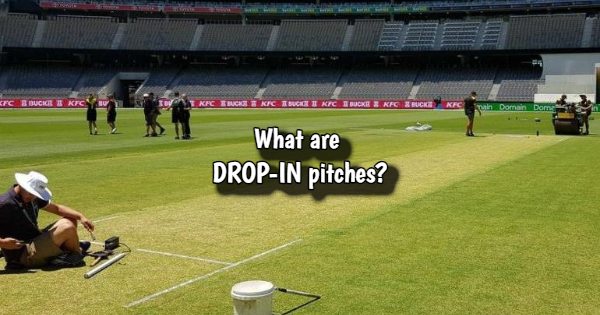The heart of a cricket match lies in the pitch, a 22-yard strip of ground where bowlers unleash their deliveries and batsmen showcase their strokeplay. Traditionally, these pitches were prepared and nurtured within the stadium itself, their character evolving over time. However, the modern cricketing landscape has witnessed the rise of a technological marvel – the drop-in pitch.
People are now reading up more on what are drop-in pitches and even on how does a drop-in pitch work, primarily because these kind of pitches are being used in the 2024 T20 World Cup in USA and West Indies. Since America doesn’t have regular cricket, it’s better to use temporary pitches which can literally be ‘dropped in’.

What are drop-in pitches?
Imagine a cricket pitch, meticulously prepared with specific soil composition, grass coverage, and moisture levels, all created away from the stadium. This is the essence of a drop-in pitch. Unlike traditional pitches that mature and deteriorate over the course of a match, drop-in pitches offer a pre-determined playing surface. These pitches are constructed in specialized nurseries, allowing for precise control over every aspect of their behavior.
Benefits of a technological marvel
So, why deviate from the age-old tradition? Drop-in pitches offer several advantages:
- Consistency: They ensure a uniform playing surface across matches, eliminating the home advantage that can arise due to natural pitch variations. This creates a fairer contest for both teams.
- Scheduling flexibility: Stadiums can host multiple matches in quick succession without worrying about the pitch deteriorating. This allows for a more packed cricketing calendar, particularly beneficial for high-profile tournaments.
- Preservation: Traditional pitches require significant rest and maintenance periods. Drop-in pitches can be removed and stored, allowing the main playing field to be used for other events.
- Customization: Nurseries can prepare pitches with specific characteristics – pitches favoring pace bowling, spin bowling, or a balanced contest. This adds another layer of strategy to the game.
SEE ALSO: List of best fantasy sports websites in India
How does a drop in pitch work?
Preparing a drop-in pitch is a meticulous process. Here’s a glimpse into the workmanship:
- Laying the foundation: A base layer with drainage systems is constructed, followed by a precisely measured soil mix replicating the desired pitch behavior.
- Grass matters: Specialized grass varieties are chosen and meticulously grown, with careful control over moisture and sunlight exposure.
- Maturation time: The pitch is allowed to mature in the nursery, with expert groundsmen monitoring its progress.
- Transportation day: Once ready, giant cranes carefully lift the pitch and transport it to the stadium, slotting it into a pre-prepared base within the ground.
Famous venues embracing change
Several iconic cricket stadiums have embraced drop-in pitches. Here are a few prominent examples:
- Melbourne Cricket Ground (MCG): This historic ground, hosting the Boxing Day Test, utilizes drop-in pitches to ensure a consistent playing surface throughout the busy Australian summer. After a poor pitch rating in 2017/18, the MCG drop-in pitch has been upgraded and is among the best in the world now.
- Perth Stadium: Known for its lively pace-bowling wickets, Optus Stadium in Perth uses drop-in pitches to maintain this characteristic across matches. The Optus Stadium drop in pitch involves a total of 5 pitches, each weighing 25 tonnes.
- The Adelaide Oval: This picturesque ground in South Australia has also adopted drop-in pitches, offering a more balanced contest between bat and ball. The Adelaide Oval drop in pitch has been managed by Damian Hough for more than a decade and they’ve got a total of 10 drop-in pitches there.
The debate and the future
While drop-in pitches offer undeniable advantages, traditionalists argue that they remove a natural element from the game. The absence of a pitch evolving through the match can make contests less unpredictable and exciting. However, drop-in pitches are here to stay. With continued advancements in pitch preparation techniques, we can expect a future where both consistency and some element of natural variation can coexist, ensuring a fair and enthralling contest on the field.
Drop-in pitches in India
Drop-in pitches are usually used in regions where cricket isn’t the only sport being played. In India, most ground are dedicated to this sport, so there’s no need for getting drop-in pitches to various venues. For similar cricket stories from around the world, remember to always stay tuned to ReadScoops.com.
Sign-up to Betvisa and get 300 FREE cash + 5 free spins



